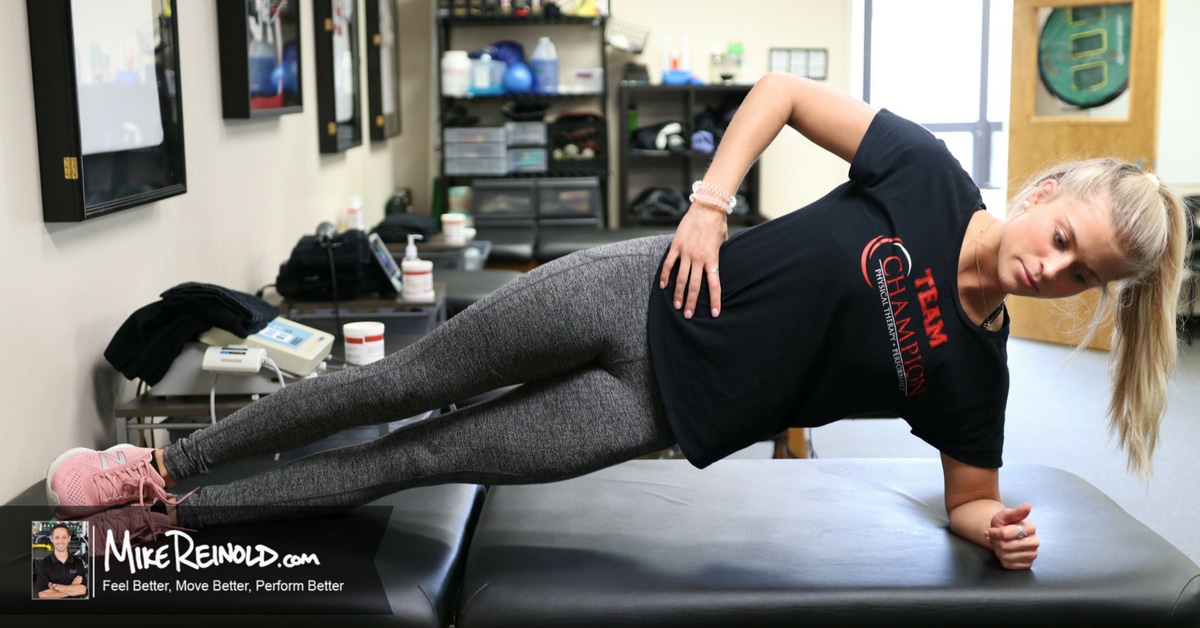We’ve come along way over the last decade when it comes to training the core. Not too long ago, training the core consisted of mainly exercises like sit ups, with no specific attention to how the core functions.
One of the key areas of core training that I focus on to enhance movement quality and performance is stabilizing the core while the arms and legs move. Essentially proximal stability, with underlying distal mobility of the extremities.
However, don’t forget that the body is amazing at compensating to get the job done.
Any lack of mobility or motor control will often result in compensatory movements. Many people want to fly through their core program, but often times don’t focus on the quality of the movement.
Here are 5 common core exercise mistakes that I see, along with some suggestions on how to fix them. I posted these as a series on Instagram, if you want to see more posts like this, be sure to follow me there.
Front Plank
A common error I see when people perform a front plank is over relying on the hip flexors to hold the position. You sometimes see them tighten their core but also come up into a bit of hip flexion.
If you hold planks for too long, you may also notice that you slowly creep up into this position as your core fatigues and your hip flexors take over.
There are two easy ways to improve this:
1. Focus on tightening your core AND your glutes. This should help hold the neutral pelvic position.
2. Perform sets of planks with each rep being ~8-10 seconds, with no break, just a quick reset, instead of sustained holds.⠀This will keep the focus on the core before the hip flexors take over.
Side Plank
Similar to the front plank, the side plank is easy to use larger muscle groups to compensate. One easy way to ruin a good side plank is simply to lift the body too high off the table. You’ll see too much side bend and will make this a lateral bend motion instead of a core stability exercise.
To fix this, try performing with a mirror so you can see your form. Your body should be in a straight line with a nice neutral spine.
Dead Bug
One of the common faults we see with the dead bug core exercises is a loss of neutral spine when the arms or the legs are full extended. ⠀The person tends to focus on getting there hands and feet extended, rather than keeping their core stable.
Remember the goal of the exercise is to brace and stabilize the core while moving the extremities.
Be sure to keep that brace, but also realize that it’s often better to reduce your arm and leg motion a bit if you are struggling and arching your back.⠀I’d rather you make the exercise less challenging, but performed well, then slowly progress over time.
Bird Dog
I’m a big fan of the bird dog exercise for two main reasons:
1) It’s great exercise to work on driving hip extension with proper core stability. A lot of people hyperextend their back instead of extending their hip.
2) Because you use alternate arm and leg for advanced variations, it also provides some rotational stability through the core.
But people LOVE to perform this exercise poorly by compensating and arching their back. Many people struggle to extend their hip while keeping their spine stable. Be sure to keep your core stable and just work on reaching with arms and legs.⠀Similar to the dead bug, I’d rather you reduce the quantity of your motion, and focus on the quality of the motion.
Glute Bridge
A common flaw with the glute bridge exercise (and hip thrusts) is thinking that you need to go as far as possible, as far as your body will go.
⠀
But keep in mind, the goal here is the glutes, not the low back. So the exercise should really be performed to extend you hips and NOT your back.
⠀
To help with this, really tighten your anterior core during the exercise and focus on squeezing your glutes. Then, simply stop the motion when the glutes are done squeezing. Many people want to keep going. They tighten their glutes, but then keep pushing the body higher over the ground. Resist the urge to continue by hyperextending at your back.
 Want to Learn More About How I Train the Core?
Want to Learn More About How I Train the Core?
Check out Eric Cressey and I’s Functional Stability Training of the Core program. We discuss the core in detail and how we rehabilitate and train the core.






